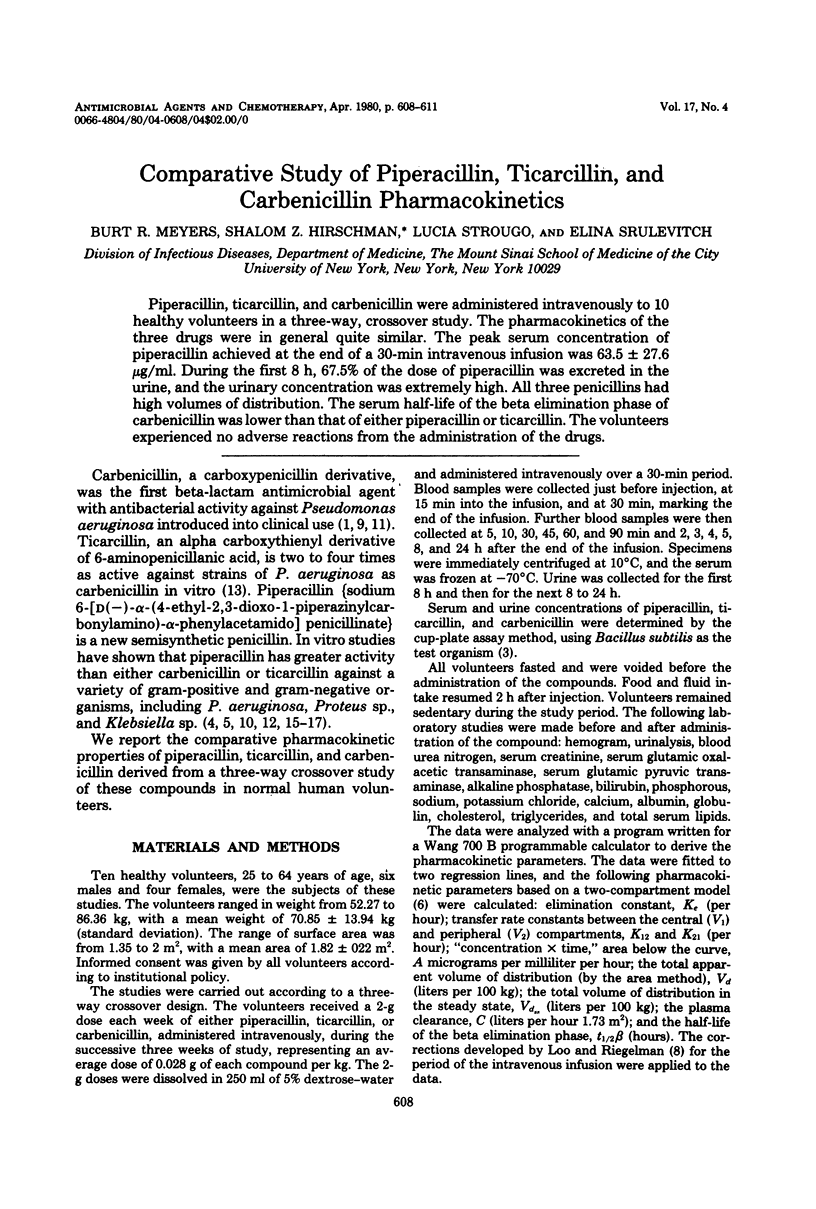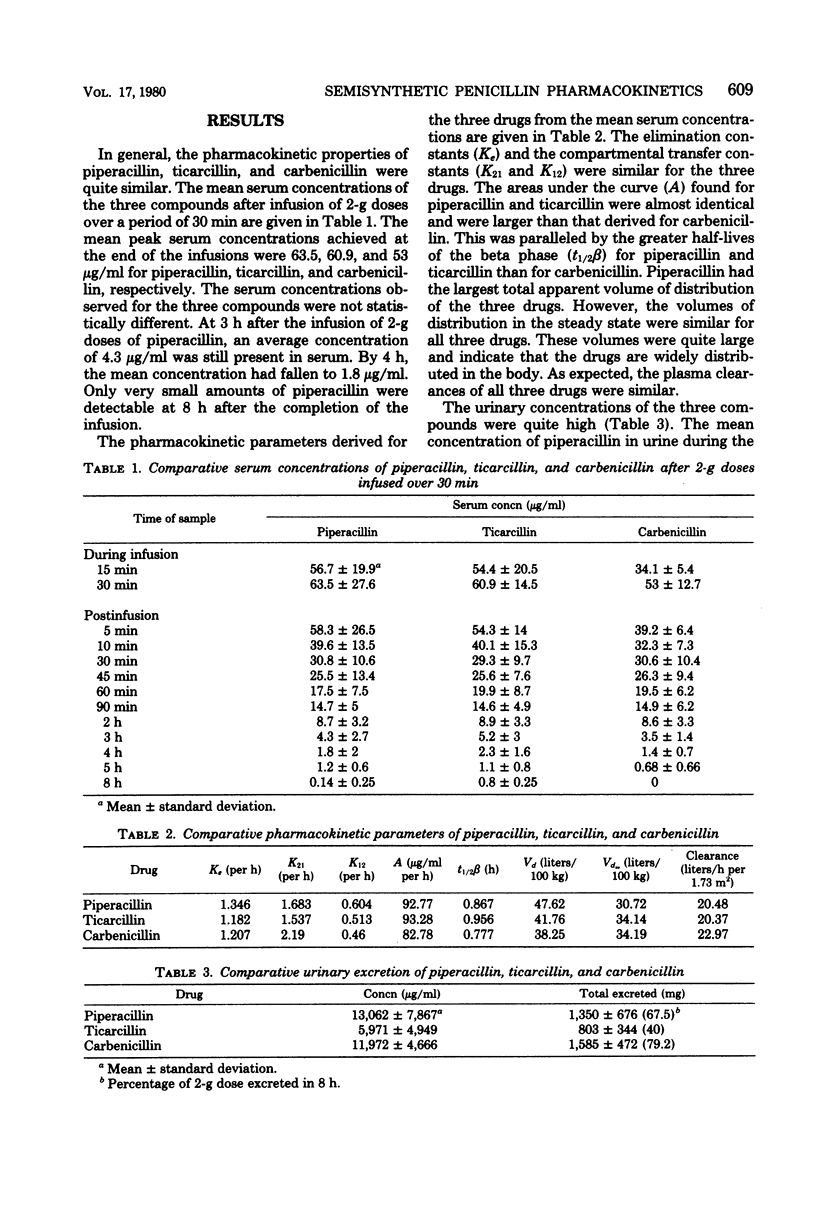Abstract
Piperacillin, ticarcillin, and carbenicillin were administered intravenously to 10 healthy volunteers in a three-way, crossover study. The pharmacokinetics of the three drugs were in general quite similar. The peak serum concentration of piperacillin achieved at the end of a 30-min intravenous infusion was 63.5 +/- 27.6 microgram/ml. During the first 8 h, 67.5% of the dose of piperacillin was excreted in the urine, and the urinary concentration was extremely high. All three penicillins had high volumes of distribution. The serum half-life of the beta elimination phase of carbenicillin was lower than that of either piperacillin or ticarcillin. The volunteers experienced no adverse reactions from the administration of the drugs.
Full text
PDF



Selected References
These references are in PubMed. This may not be the complete list of references from this article.
- Bodey G. P., Whitecar J. P., Jr, Middleman E., Rodriguez V. Carbenicillin therapy for pseudomonas infections. JAMA. 1971 Oct 4;218(1):62–66. [PubMed] [Google Scholar]
- Cole M., Kenig M. D., Hewitt V. A. Metabolism of penicillins to penicilloic acids and 6-aminopenicillanic acid in man and its significance in assessing penicillin absorption. Antimicrob Agents Chemother. 1973 Apr;3(4):463–468. doi: 10.1128/aac.3.4.463. [DOI] [PMC free article] [PubMed] [Google Scholar]
- Evans M. A., Wilson P., Leung T., Williams J. D. Pharmacokinetics of piperacillin following intravenous administration. J Antimicrob Chemother. 1978 May;4(3):255–261. doi: 10.1093/jac/4.3.255. [DOI] [PubMed] [Google Scholar]
- Fu K. P., Neu H. C. Piperacillin, a new penicillin active against many bacteria resistant to other penicillins. Antimicrob Agents Chemother. 1978 Mar;13(3):358–367. doi: 10.1128/aac.13.3.358. [DOI] [PMC free article] [PubMed] [Google Scholar]
- George W. L., Lewis R. P., Meyer R. D. Susceptibility of cephalothin-resistant gram-negative bacilli to piperacillin, cefuroxime, and other selected antibiotics. Antimicrob Agents Chemother. 1978 Mar;13(3):484–489. doi: 10.1128/aac.13.3.484. [DOI] [PMC free article] [PubMed] [Google Scholar]
- Greenblatt D. J., Kock-Weser J. Drug therapy. Clinical Pharmacokinetics (first of two parts). N Engl J Med. 1975 Oct 2;293(14):702–705. doi: 10.1056/NEJM197510022931406. [DOI] [PubMed] [Google Scholar]
- Libke R. D., Clarke J. T., Ralph E. D., Luthy R. P., Kirby W. M. Ticarcillin vs carbenicillin: clinical pharmacokinetics. Clin Pharmacol Ther. 1975 Apr;17(4):441–446. doi: 10.1002/cpt1975174441. [DOI] [PubMed] [Google Scholar]
- Loo J. C., Riegelman S. Assessment of pharmacokinetic constants from postinfusion blood curves obtained after I.V. infusion. J Pharm Sci. 1970 Jan;59(1):53–55. doi: 10.1002/jps.2600590107. [DOI] [PubMed] [Google Scholar]
- Lowbury E. J., Lilly H. A., Kidson A., Ayliffe G. A., Jones R. J. Sensitivity of Pseudomonas aeruginosa to antibiotics: emergence of strains highly resistant to carbenicillin. Lancet. 1969 Aug 30;2(7618):448–452. doi: 10.1016/s0140-6736(69)90163-9. [DOI] [PubMed] [Google Scholar]
- McGowan J. E., Jr, Terry P. M. Susceptibility of gram-negative aerobic bacilli resistant to carbenicillin in a general hospital to piperacillin and ticarcillin. Antimicrob Agents Chemother. 1979 Jan;15(1):137–139. doi: 10.1128/aac.15.1.137. [DOI] [PMC free article] [PubMed] [Google Scholar]
- Meyers B. R., Sabbaj J., Weinstein L. Bacteriological, pharmacological, and clinical studies of carbenicillin. Arch Intern Med. 1970 Feb;125(2):282–286. [PubMed] [Google Scholar]
- Milne S. E., Waterworth P. M. Piperacillin, a new penicillin with high anti-pseudomonal activity. J Antimicrob Chemother. 1978 May;4(3):247–254. doi: 10.1093/jac/4.3.247. [DOI] [PubMed] [Google Scholar]
- Neu H. C., Garvey G. J. Comparative in vitro activity and clinical pharmacology of ticarcillin and carbenicillin. Antimicrob Agents Chemother. 1975 Oct;8(4):457–462. doi: 10.1128/aac.8.4.457. [DOI] [PMC free article] [PubMed] [Google Scholar]
- Rodriguez V., Inagaki J., Bodey G. P. Clinical pharmacology of ticarcillin (alpha-carboxyl-3-thienylmethyl penicillin, BRL-2288). Antimicrob Agents Chemother. 1973 Jul;4(1):31–36. doi: 10.1128/aac.4.1.31. [DOI] [PMC free article] [PubMed] [Google Scholar]
- Ueo K., Fukuoka Y., Hayashi T., Yasuda T., Taki H., Tai M., Watanabe Y., Saikawa I., Mitsuhashi S. In vitro and in vivo antibacterial activity of T-1220, a new semisynthetic penicillin. Antimicrob Agents Chemother. 1977 Oct;12(4):455–460. doi: 10.1128/aac.12.4.455. [DOI] [PMC free article] [PubMed] [Google Scholar]
- Verbist L. In vitro activity of piperacillin, a new semisynthetic penicillin with an unusually broad spectrum of activity. Antimicrob Agents Chemother. 1978 Mar;13(3):349–357. doi: 10.1128/aac.13.3.349. [DOI] [PMC free article] [PubMed] [Google Scholar]
- Winston D. J., Wang D., Young L. S., Martin W. J., Hewitt W. L. In vitro studies of piperacilin, a new semisynthetic penicillin. Antimicrob Agents Chemother. 1978 Jun;13(6):944–950. doi: 10.1128/aac.13.6.944. [DOI] [PMC free article] [PubMed] [Google Scholar]


